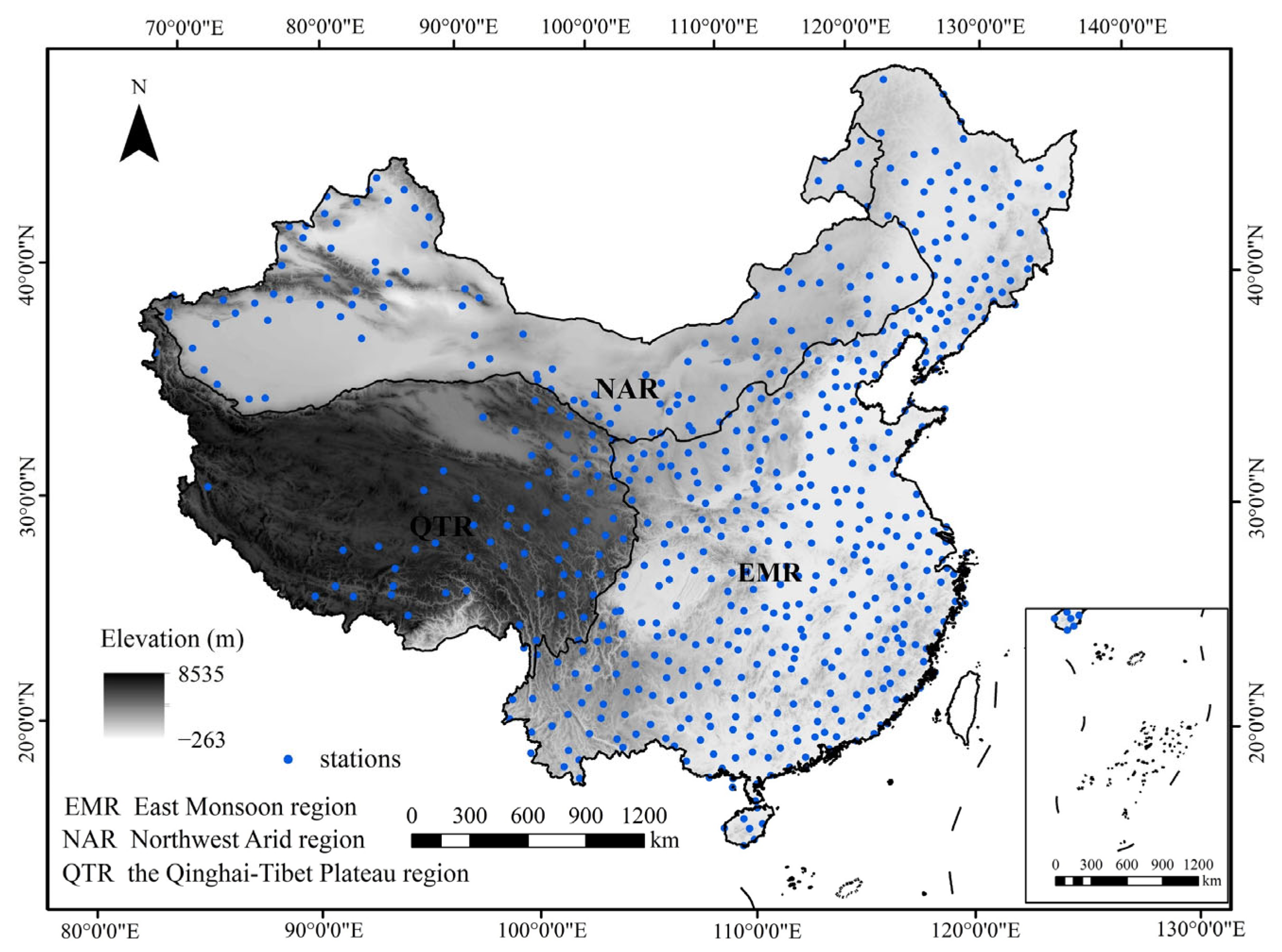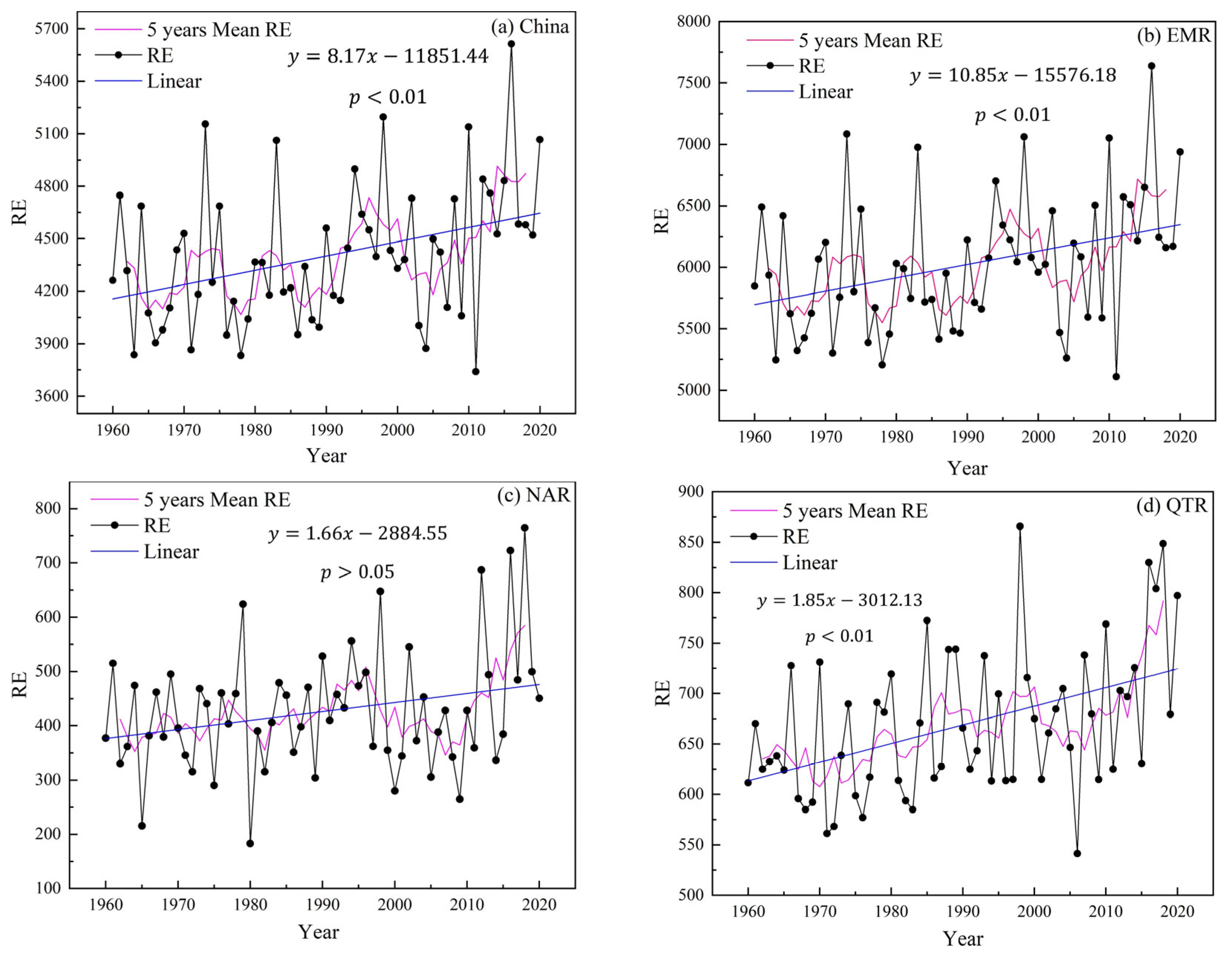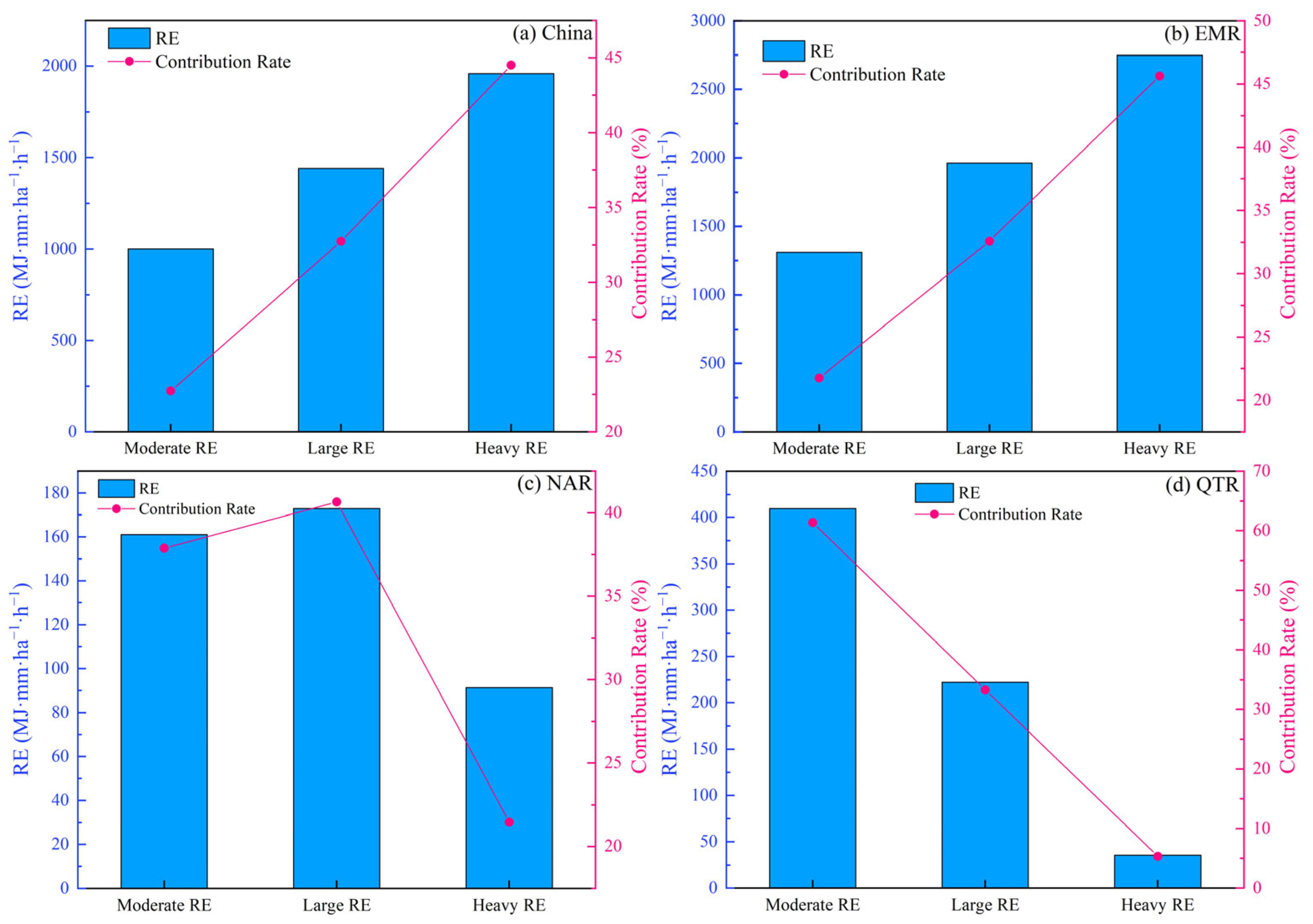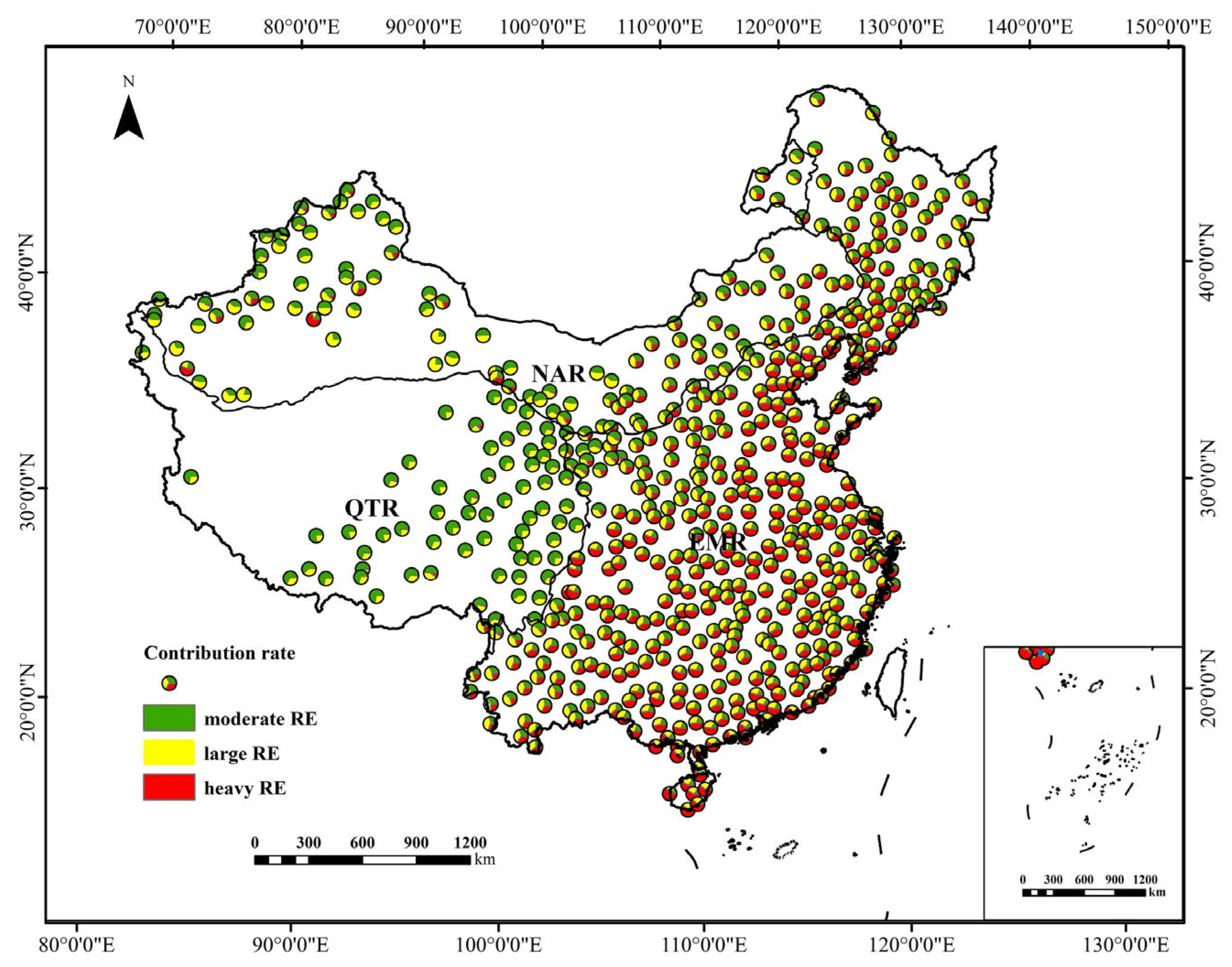Spatiotemporal Variability in Rainfall Erosivity and Its Teleconnection with Atmospheric Circulation Indices in China
Abstract
:1. Introduction
2. Materials and Methods
2.1. Study Area and Data
2.2. RE Calculation Procedure
2.3. Linear Regression
2.4. Mann–Kendall Test
2.5. Random Forest Model
2.6. Contribution Rates
3. Results
3.1. Temporal Variation Analysis of RE
3.2. Spatial Distribution of RE
3.3. Contribution Rates for RE Generated by Different Levels of Rainfall
3.4. Relationship between Rainfall and RE
3.5. Role of Impact Factors on RE through Random Forest
4. Discussion
4.1. Spatiotemporal Variability in RE in China
4.2. RE Related to Atmospheric Circulation Indices
4.3. Sensitivity of RE to Rainfall
5. Conclusions
- (1)
- In the entire region of China, the annual RE shows a significant increasing trend, with a change rate of 81.7 MJ·mm·ha−1·h−1/decade. In the three subregions, EMR and QTR also exhibit significant increasing trends in annual RE, while NAR shows a nonsignificant increasing trend.
- (2)
- There are differences in the dominant types of RE among the three subregions. In EMR, heavy RE prevails; in NAR, large RE is dominant; and in QTR, moderate RE prevails.
- (3)
- In three different regions of China, the dominant atmospheric circulation indices affecting RE are not the same. WHWP, NAO, and AMO events are the dominant circulation factors influencing changes in RE in the EMR, NAR, and QTR, respectively.
- (4)
- In China, there is spatial variation in the sensitivity of RE to annual rainfall changes. The EMR exhibits the highest sensitivity to rainfall changes, with a sensitivity coefficient of 8.71 MJ·mm·ha−1·h−1/mm, followed by a decreasing sensitivity in NAR and QTR.
Author Contributions
Funding
Institutional Review Board Statement
Informed Consent Statement
Data Availability Statement
Conflicts of Interest
References
- Hoyos, N.; Waylen, P.R.; Jaramillo, Á. Seasonal and spatial patterns of erosivity in a tropical watershed of the Colombian Andes. J. Hydrol. 2005, 314, 177–191. [Google Scholar] [CrossRef]
- Jiang, N.; Yao, F.; Liu, T.; Chen, Z.; Hu, C.; Geng, X. Estimating the Soil Erosion Response to Land-Use Change Using GIS-Based RUSLE and Remote Sensing: A Case Study of Heilongjiang Province, China. Sustainability 2023, 15, 8004. [Google Scholar] [CrossRef]
- Lai, C.; Chen, X.; Wang, Z.; Wu, X.; Zhao, S.; Wu, X.; Bai, W. Spatio-temporal variation in rainfall erosivity during 1960–2012 in the Pearl River Basin, China. Catena 2016, 137, 382–391. [Google Scholar] [CrossRef]
- Lee, J.-H.; Heo, J.-H. Evaluation of estimation methods for rainfall erosivity based on annual precipitation in Korea. J. Hydrol. 2011, 409, 30–48. [Google Scholar] [CrossRef]
- Wischmeier, W.H.; Smith, D.D. Predicting Rainfall Erosion Losses: A Guide to Conservation Planning (No. 537); Department of Agriculture, Science and Education Administration: Washington, DC, USA, 1978.
- Renard, K.G.; Foster, G.R.; Weesies, G.A.; Mccool, D.K.; Yoder, D.C. Predicting Soil Erosion by Water: A Guide to Conservation Planning with the Revised Universal Soil Loss Equation (RUSLE); Agriculture Handbook; USDA: Washington, DC, USA, 1997.
- Lin, J.; Lin, Y.; Zhao, H.; He, H. Soil Erosion Processes and Geographical Differentiation in Shaanxi during 1980–2015. Sustainability 2022, 14, 10512. [Google Scholar] [CrossRef]
- Fang, F.; Fang, Q.; Yu, W.; Fan, C.; Zi, R.; Zhao, L. RUSLE Model Evaluation of the Soil and Water Conservation Ratio of the Guizhou Province in China between 2000 and 2019. Sustainability 2022, 14, 8219. [Google Scholar] [CrossRef]
- Ali, A.A.; Al-Abbadi, A.M.; Jabbar, F.K.; Alzahrani, H.; Hamad, S. Predicting Soil Erosion Rate at Transboundary Sub-Watersheds in Ali Al-Gharbi, Southern Iraq, Using RUSLE-Based GIS Model. Sustainability 2023, 15, 1776. [Google Scholar] [CrossRef]
- Wang, Z.; Su, Y. Assessment of Soil Erosion in the Qinba Mountains of the Southern Shaanxi Province in China Using the RUSLE Model. Sustainability 2020, 12, 1733. [Google Scholar] [CrossRef]
- Chen, G.; Zhang, Z.; Guo, Q.; Wang, X.; Wen, Q. Quantitative Assessment of Soil Erosion Based on CSLE and the 2010 National Soil Erosion Survey at Regional Scale in Yunnan Province of China. Sustainability 2019, 11, 3252. [Google Scholar] [CrossRef]
- He, J.; Wan, Y.-R.; Chen, H.-T.; Wang, S.-L. Effects of Land Use Change on Rainfall Erosion in Luojiang River Basin, China. Sustainability 2022, 14, 8441. [Google Scholar] [CrossRef]
- Xu, Y.; Sun, H.; Ji, X. Spatial-temporal evolution and driving forces of rainfall erosivity in a climatic transitional zone: A case in Huaihe River Basin, eastern China. Catena 2021, 198, 104993. [Google Scholar] [CrossRef]
- Lee, J.H.; Julien, P.Y.; Cho, J.; Lee, S.; Kim, J.; Kang, W. Rainfall erosivity variability over the United States associated with large-scale climate variations by El Niño/southern oscillation. Catena 2023, 226, 107050. [Google Scholar] [CrossRef]
- Shin, J.-Y.; Kim, T.; Heo, J.-H.; Lee, J.-H. Spatial and temporal variations in rainfall erosivity and erosivity density in South Korea. Catena 2019, 176, 125–144. [Google Scholar] [CrossRef]
- Sujatha, E.R.; Sridhar, V. Landslide susceptibility analysis: A logistic regression model case study in Coonoor, India. Hydrology 2021, 8, 41. [Google Scholar] [CrossRef]
- Sujatha, E.R.; Sridhar, V. Mapping debris flow susceptibility using analytical network process in Kodaikkanal Hills, Tamil Nadu (India). J. Earth Syst. Sci. 2017, 126, 116. [Google Scholar] [CrossRef]
- Ballabio, C.; Borrelli, P.; Spinoni, J.; Meusburger, K.; Michaelides, S.; Begueria, S.; Klik, A.; Petan, S.; Janecek, M.; Olsen, P.; et al. Mapping monthly rainfall erosivity in Europe. Sci. Total Environ. 2017, 579, 1298–1315. [Google Scholar] [CrossRef] [PubMed]
- Klik, A.; Haas, K.; Dvorackova, A.; Fuller, I.C. Spatial and temporal distribution of rainfall erosivity in New Zealand. Soil Res. 2015, 53, 815–825. [Google Scholar] [CrossRef]
- Feng, Q.; Dong, L.; Liu, J.; Liu, H. Detection Framework of Abrupt Changes and Trends in Rainfall Erosivity in Three Gorges Reservoir, China. Sustainability 2023, 15, 2062. [Google Scholar] [CrossRef]
- Micic Ponjiger, T.; Lukic, T.; Basarin, B.; Jokic, M.; Wilby, R.L.; Pavic, D.; Mesaros, M.; Valjarevic, A.; Milanovic, M.M.; Morar, C. Detailed Analysis of Spatial-Temporal Variability of Rainfall Erosivity and Erosivity Density in the Central and Southern Pannonian Basin. Sustainability 2021, 13, 13355. [Google Scholar] [CrossRef]
- Musabbir, M.; Islam, A.R.M.T.; Rahman, M.S.; Pal, S.C.; Alam, E.; Mallick, J. Spatiotemporal variability of rainfall erosivity and its teleconnection with atmospheric circulation in monsoon-driven climate region. Catena 2023, 221, 106762. [Google Scholar] [CrossRef]
- Patriche, C.V.; Rosca, B.; Pirnau, R.G.; Vasiliniuc, I.; Irimia, L.M. Simulation of Rainfall Erosivity Dynamics in Romania under Climate Change Scenarios. Sustainability 2023, 15, 1469. [Google Scholar] [CrossRef]
- Qin, W.; Guo, Q.; Zuo, C.; Shan, Z.; Ma, L.; Sun, G. Spatial distribution and temporal trends of rainfall erosivity in mainland China for 1951–2010. Catena 2016, 147, 177–186. [Google Scholar] [CrossRef]
- Chen, Y.; Xu, M.; Wang, Z.; Chen, W.; Lai, C. Reexamination of the Xie model and spatiotemporal variability in rainfall erosivity in mainland China from 1960 to 2018. Catena 2020, 195, 104837. [Google Scholar] [CrossRef]
- Feng, R.; Jiazhen, L.; Yongjin, C.; Zhenfang, H. Variations analysis of multi-years rainfall erosivity and erosivity growth rate in Shandong Province. J. Nat. Disasters 2017, 26, 83–92. [Google Scholar]
- Zhao, P.; Ping, G. Characteristics of Rainfall Erosivity Changes in Northwest Yunnan from 1980 to 2013. Sci. Geogr. Sin. 2015, 35, 1306–1311. [Google Scholar]
- Li, W.; Wang, J. Spatial and temporal variations of rainfall erosivity at each level in Taihang Mountain. J. Nat. Resour. 2019, 34, 785–801. [Google Scholar] [CrossRef]
- Jiang, G.Y.; Lv, J.R.; He, X.B.; Bao, Y.H. Influence of reservoir impoundment on rainfall erosivity in the Three Gorges Reservoir region of China. Hydrol. Res. 2022, 53, 1357–1371. [Google Scholar] [CrossRef]
- Li, J.; Sheng, F.; Liu, S.; Zhang, T.; Yu, M. Variation of Rainfall Erosivity and Its Influencing Factors in Jiuqushui Watershed, Southern Jiangxi Province. J. Soil Water Conserv. 2022, 36, 63–73. [Google Scholar]
- Martin-Benito, D.; Ummenhofer, C.C.; Köse, N.; Güner, H.T.; Pederson, N. Tree-ring reconstructed May–June precipitation in the Caucasus since 1752 CE. Clim. Dyn. 2016, 47, 3011–3027. [Google Scholar] [CrossRef]
- Lu, E.; Liu, S.; Luo, Y.; Zhao, W.; Li, H.; Chen, H.; Zeng, Y.; Liu, P.; Wang, X.; Higgins, R.W.; et al. The atmospheric anomalies associated with the drought over the Yangtze River basin during spring 2011. J. Geophys. Res. Atmos. 2014, 119, 5881–5894. [Google Scholar] [CrossRef]
- Sun, J.; Yang, K.; Guo, W.; Wang, Y.; He, J.; Lu, H. Why Has the Inner Tibetan Plateau Become Wetter since the Mid-1990s? J. Clim. 2020, 33, 8507–8522. [Google Scholar] [CrossRef]
- Zhang, T.; Wang, Y.; Liu, B.; Sun, Y.; Chen, X. Variation of Hourly Extreme Precipitation in the Three Gorges Reservoir Region, China, from the Observation Record. Water 2021, 13, 2855. [Google Scholar] [CrossRef]
- Wang, P.; Wu, X.; Hao, Y.; Wu, C.; Zhang, J. Is Southwest China drying or wetting? Spatiotemporal patterns and potential causes. Theor. Appl. Climatol. 2019, 139, 1–15. [Google Scholar] [CrossRef]
- Rahman, M.S.; Islam, A. Are precipitation concentration and intensity changing in Bangladesh overtimes? Analysis of the possible causes of changes in precipitation systems. Sci. Total Environ. 2019, 690, 370–387. [Google Scholar] [CrossRef] [PubMed]
- Bhattacharyya, S. Possible association between Indian monsoon rainfall and solar activity. Geophys. Res. Lett. 2005, 32, GL021044. [Google Scholar] [CrossRef]
- Panagos, P.; Ballabio, C.; Borrelli, P.; Meusburger, K. Spatio-temporal analysis of rainfall erosivity and erosivity density in Greece. Catena 2016, 137, 161–172. [Google Scholar] [CrossRef]
- Angulo-Martínez, M.; Beguería, S. Do atmospheric teleconnection patterns influence rainfall erosivity? A study of NAO, MO and WeMO in NE Spain, 1955–2006. J. Hydrol. 2012, 450–451, 168–179. [Google Scholar] [CrossRef]
- Lee, J.H.; Lee, J.-H.; Julien, P.Y. Global climate teleconnection with rainfall erosivity in South Korea. Catena 2018, 167, 28–43. [Google Scholar] [CrossRef]
- Cao, Q.; Yuan, X.; Yan, Q.; Zhu, F. Decadal change of rainfall erosivity during rainy season in mainland China and its underlying causes. J. Hydrol. 2023, 620, 129391. [Google Scholar] [CrossRef]
- Liu, S.; Huang, S.; Xie, Y.; Leng, G.; Huang, Q.; Wang, L.; Xue, Q. Spatial-temporal changes of rainfall erosivity in the loess plateau, China: Changing patterns, causes and implications. Catena 2018, 166, 279–289. [Google Scholar] [CrossRef]
- Ponjiger, T.M.; Lukic, T.; Wilby, R.L.; Markovic, S.B.; Valjarevic, A.; Dragicevic, S.; Gavrilov, M.B.; Ponjiger, I.; Durlevic, U.; Milanovic, M.M.; et al. Evaluation of Rainfall Erosivity in the Western Balkans by Mapping and Clustering ERA5 Reanalysis Data. Atmosphere 2023, 14, 104. [Google Scholar] [CrossRef]
- Zhang, W.; Yun, X.; Baoyuan, L. Spatial Distribution of Rainfall Erosivity in China. Mt. Res. 2003, 21, 33–40. [Google Scholar]
- Zhu, Z.; Yu, B. Validation of rainfall erosivity estimators for mainland China. Trans. ASABE 2015, 58, 61–71. [Google Scholar]
- Zhang, J.; Ren, Y.; Jiao, P.; Xiao, P.; Li, Z. Changes in rainfall erosivity from combined effects of multiple factors in China’s Loess Plateau. Catena 2022, 216, 106373. [Google Scholar] [CrossRef]
- Ma, X.; He, Y.; Xu, J.; van Noordwijk, M.; Lu, X. Spatial and temporal variation in rainfall erosivity in a Himalayan watershed. Catena 2014, 121, 248–259. [Google Scholar] [CrossRef]
- Xu, X.; Yan, Y.; Dai, Q.; Yi, X.; Hu, Z.; Cen, L. Spatial and temporal dynamics of rainfall erosivity in the karst region of southwest China: Interannual and seasonal changes. Catena 2023, 221, 106763. [Google Scholar] [CrossRef]
- Xu, L.; Xu, X.; Meng, X. Risk assessment of soil erosion in different rainfall scenarios by RUSLE model coupled with Information Diffusion Model: A case study of Bohai Rim, China. Catena 2013, 100, 74–82. [Google Scholar] [CrossRef]
- Da Silva, A.M. Rainfall erosivity map for Brazil. Catena 2004, 57, 251–259. [Google Scholar] [CrossRef]
- Zhang, Y.; Zhang, M.; Wang, S.; Du, M.; Ma, R.; Wang, J. Changes of precipitation area in China from 1961 to 2015. Arid Land Geogr. 2019, 42, 762–773. [Google Scholar]
- Ding, Z.; Lu, R.; Wang, Y. Spatiotemporal variations in extreme precipitation and their potential driving factors in non-monsoon regions of China during 1961–2017. Environ. Res. Lett. 2019, 14, 024005. [Google Scholar] [CrossRef]
- Wu, Y.; Ji, H.; Wen, J.; Wu, S.-Y.; Xu, M.; Tagle, F.; He, B.; Duan, W.; Li, J. The characteristics of regional heavy precipitation events over eastern monsoon China during 1960–2013. Glob. Planet. Chang. 2019, 172, 414–427. [Google Scholar] [CrossRef]
- Zhao, D.; Xiong, D.; Zhang, B.; He, K.; Wu, H.; Zhang, W.; Lu, X. Long-term response of runoff and sediment load to spatiotemporally varied rainfall in the Lhasa River basin, Tibetan Plateau. J. Hydrol. 2023, 618, 129154. [Google Scholar] [CrossRef]
- Gong, X.W.; Wang, X.Y.; Li, Y.Q.; Ma, L.; Li, M.Y.; Si, H.T. Observed Changes in Extreme Temperature and Precipitation Indices on the Qinghai-Tibet Plateau, 1960–2016. Front. Environ. Sci. 2022, 10, 888937. [Google Scholar] [CrossRef]
- Ding, Y.H. Summer Monsoon Rainfalls in China. J. Meteorol. Soc. Jpn. 1992, 70, 373–396. [Google Scholar] [CrossRef]
- Wang, N.; Cheng, W.; Lombardo, L.; Xiong, J.; Guo, L. Statistical spatiotemporal analysis of hydro-morphological processes in China during 1950–2015. Stoch. Environ. Res. Risk Assess. 2022, 36, 2377–2397. [Google Scholar] [CrossRef]
- Wang, Y.; Yang, K.; Huang, W.Y.; Qiu, T.P.; Wang, B.B. Dominant Contribution of South Asia Monsoon to External Moisture for Extreme Precipitation Events in Northern Tibetan Plateau. Remote Sens. 2023, 15, 735. [Google Scholar] [CrossRef]
- Zhou, Y.S.; Xie, Z.M.; Liu, X. An Analysis of Moisture Sources of Torrential Rainfall Events over Xinjiang, China. J. Hydrometeorol. 2019, 20, 2109–2122. [Google Scholar] [CrossRef]
- Du, Q.; Zhang, M.; Wang, S.; Che, C.; Qiu, X.; Ma, Z. Changes in air temperature of China in response to global warming hiatus. Acta Geogr. Sin. 2018, 73, 1748–1764. [Google Scholar]
- Ejaz, N.; Elhag, M.; Bahrawi, J.; Zhang, L.; Gabriel, H.F.; Rahman, K.U. Soil Erosion Modelling and Accumulation Using RUSLE and Remote Sensing Techniques: Case Study Wadi Baysh, Kingdom of Saudi Arabia. Sustainability 2023, 15, 3218. [Google Scholar] [CrossRef]
- Wu, J.; Cheng, Y.; Mu, Z.; Dong, W.; Zheng, Y.; Chen, C.; Wang, Y. Temporal Spatial Mutations of Soil Erosion in the Middle and Lower Reaches of the Lancang River Basin and Its Influencing Mechanisms. Sustainability 2022, 14, 5169. [Google Scholar] [CrossRef]
- Zhang, W.B.; Xie, Y.; Liu, B.Y. Rainfall erosivity estimation using daily rainfall amounts. Sci. Geogr. Sin. 2002, 22, 705–711. [Google Scholar]
- Zhang, W.B.; Fu, J.S. Rainfall erosivity estimation under different rainfall amount. Resour. Sci. 2003, 25, 35–41. [Google Scholar]
- Mann, H.B. Nonparametric Tests Against Trend. Econometrica 1945, 13, 245–259. [Google Scholar] [CrossRef]
- Kendall, M.G. Further Contributions to the Theory of Paired Comparisons. Biometrics 1955, 11, 43–62. [Google Scholar] [CrossRef]
- Huang, J.; Zhang, J.; Zhang, Z.; Xu, C.-Y. Spatial and temporal variations in rainfall erosivity during 1960–2005 in the Yangtze River basin. Stoch. Environ. Res. Risk Assess. 2013, 27, 337–351. [Google Scholar] [CrossRef]
- Wang, Z.; Lai, C.; Chen, X.; Yang, B.; Zhao, S.; Bai, X. Flood hazard risk assessment model based on random forest. J. Hydrol. 2015, 527, 1130–1141. [Google Scholar] [CrossRef]
- Calle, M.L.; Urrea, V. Letter to the Editor: Stability of Random Forest importance measures. Brief. Bioinform. 2011, 12, 86–89. [Google Scholar] [CrossRef] [PubMed]
- Zheng, Y.; He, Y.; Chen, X. Spatiotemporal pattern of precipitation concentration and its possible causes in the Pearl River basin, China. J. Clean. Prod. 2017, 161, 1020–1031. [Google Scholar] [CrossRef]
- Zhang, A.; Zhao, X. Changes of precipitation pattern in China: 1961–2010. Theor. Appl. Climatol. 2022, 148, 1005–1019. [Google Scholar] [CrossRef]
- Wang, R.; Fu, Y.; Xian, T.; Chen, F.; Yuan, R.; Li, R.; Liu, G. Evaluation of Atmospheric Precipitable Water Characteristics and Trends in Mainland China from 1995 to 2012. J. Clim. 2017, 30, 8673–8688. [Google Scholar] [CrossRef]
- Su, B.; Xiao, C.; Zhao, H.; Huang, Y.; Dou, T.; Wang, X.; Chen, D. Estimated changes in different forms of precipitation (snow, sleet, and rain) across China: 1961–2016. Atmos. Res. 2022, 270, 106078. [Google Scholar] [CrossRef]
- Wang, W.; Yin, S.; Gao, G.; Papalexiou, S.M.; Wang, Z. Increasing trends in rainfall erosivity in the Yellow River basin from 1971 to 2020. J. Hydrol. 2022, 610, 127851. [Google Scholar] [CrossRef]
- Xin, Z.; Yu, X.; Li, Q.; Lu, X.X. Spatiotemporal variation in rainfall erosivity on the Chinese Loess Plateau during the period 1956–2008. Reg. Environ. Chang. 2011, 11, 149–159. [Google Scholar] [CrossRef]
- Angulo-Martinez, M.; Begueria, S. Trends in rainfall erosivity in NE Spain at annual, seasonal and daily scales, 1955–2006. Hydrol. Earth Syst. Sci. 2012, 16, 3551–3559. [Google Scholar] [CrossRef]
- Wu, Y.; Mu, H.; Wu, S.-y.; Xu, Y.; Xu, M.; Wu, H.; Clark, R.T.; Gao, C. Changes in mean and extreme homogeneous precipitation in China during 1960–2020. Atmos. Res. 2023, 292, 106891. [Google Scholar] [CrossRef]
- Panagos, P.; Borrelli, P.; Meusburger, K.; Yu, B.; Klik, A.; Jae Lim, K.; Yang, J.E.; Ni, J.; Miao, C.; Chattopadhyay, N.; et al. Global rainfall erosivity assessment based on high-temporal resolution rainfall records. Sci. Rep. 2017, 7, 4175. [Google Scholar] [CrossRef] [PubMed]
- Zeng, L.; Liu, W.; Liu, Z.; Gao, Y. Evaluating the effects of topographical factors on the precipitation simulated by kilometer-scale versus quarter-degree dynamical downscaling models in eastern China. Atmos. Ocean. Sci. Lett. 2023, 16, 100287. [Google Scholar] [CrossRef]
- Luo, H.; Wang, Z.; Yang, S.; Hua, W. Revisiting the impact of Asian large-scale orography on the summer precipitation in Northwest China and surrounding arid and semi-arid regions. Clim. Dyn. 2022, 60, 33–46. [Google Scholar] [CrossRef]
- Wei, L.; Hu, K.H.; Hu, X.D. Rainfall occurrence and its relation to flood damage in China from 2000 to 2015. J. Mt. Sci. 2018, 15, 2492–2504. [Google Scholar] [CrossRef]
- Xu, X.; Zhang, X.; Dai, E.; Song, W. Reseach of trend variability of precipitation intensity and their contribution to precipitation in China from 1961 to 2010. Geogr. Res. 2014, 33, 1335–1347. [Google Scholar]
- Yao, C.; Qian, W.; Yang, S.; Lin, Z. Regional features of precipitation over Asia and summer extreme precipitation over Southeast Asia and their associations with atmospheric–oceanic conditions. Meteorol. Atmos. Phys. 2009, 106, 57–73. [Google Scholar] [CrossRef]
- Cui, D.; Wang, C.; Santisirisomboon, J. Characteristics of extreme precipitation over eastern Asia and its possible connections with Asian summer monsoon activity. Int. J. Climatol. 2019, 39, 711–723. [Google Scholar] [CrossRef]
- Tang, Y.; Huang, A.; Wu, P.; Huang, D.; Xue, D.; Wu, Y. Drivers of Summer Extreme Precipitation Events Over East China. Geophys. Res. Lett. 2021, 48, e2021GL093670. [Google Scholar] [CrossRef]
- Tong, X.; Liu, X.; Jia, Q.; Yingming, H.; Yang, C. Spatial and Temporal Variability of Daily Precipitation Concentration in China during 1960−2011. Clim. Environ. Res. 2017, 22, 301–314. [Google Scholar]
- Xu, L.; Zhou, H.; Liang, C.; Du, L.; Li, H. Spatial and temporal variability of annual and seasonal precipitation over the desert region of China during 1951–2005. Hydrol. Process. 2010, 24, 2947–2959. [Google Scholar] [CrossRef]
- Ayitken, M.; Yang, L.; Zhang, Y.; Musa, Y. Characteristic analysis of environment of short-time heavy rainfall under the background of the Central Asian Vortex in Xinjiang in recent ten years. Arid Land Geogr. 2018, 41, 273–281. [Google Scholar]
- Qin, H.; Chen, C.; Ablimitijan, A.; Li, N. Characteristics of Short-duration Heavy Rainfall in Warm Season in Xinjiang. Arid Zone Res. 2019, 36, 1440–1449. [Google Scholar]
- Abbas, A.; Zhang, T.; He, Q.; Bo, L.; Jin, L.; Zhang, J.; Salam, A. Variations in different types and levels of daily precipitation in the Tarim Basin, Northwest China. Theor. Appl. Climatol. 2022, 149, 1509–1520. [Google Scholar] [CrossRef]
- Cao, W.F.; Li, J.H.; Acharya, S. Cryospheric changes in the Tibetan Plateau and its effects on ecosystem. In Proceedings of the International Conference on Intelligent Transportation, Big Data and Smart City (ICITBS), Halong Bay, Vietnam, 19–20 December 2015. [Google Scholar]
- Park, J.H.; Kug, J.S.; An, S.I.; Li, T. Role of the western hemisphere warm pool in climate variability over the western North Pacific. Clim. Dyn. 2019, 53, 2743–2755. [Google Scholar] [CrossRef]
- Lee, H.F.; Zhang, D.D. Relationship between NAO and drought disasters in northwestern China in the last millennium. J. Arid Environ. 2011, 75, 1114–1120. [Google Scholar] [CrossRef]
- Yu, Y.; Yang, T.; Li, J.; Liu, J.; An, C.; Liu, X.; Fan, Z.; Lu, Z.; Li, Y.; Su, X. Millennial-scale Holocene climate variability in the NW China drylands and links to the tropical Pacific and the North Atlantic. Paleogeogr. Paleoclimatol. Paleoecol. 2006, 233, 149–162. [Google Scholar] [CrossRef]
- Zhang, L.; Shen, M.; Shi, C.; Shi, F.; Jiang, N.; Yang, Z.; Ji, Z. Local Climatic Factors Mediated Impacts of Large-Scale Climate Oscillations on the Growth of Vegetation Across the Tibetan Plateau. Front. Environ. Sci. 2021, 9, 597971. [Google Scholar] [CrossRef]
- Shen, X.; Liu, B.; Li, G.; Wu, Z.; Jin, Y.; Yu, P.; Zhou, D. Spatiotemporal change of diurnal temperature range and its relationship with sunshine duration and precipitation in China. J. Geophys. Res. Atmos. 2015, 119, 13–163, 179. [Google Scholar]
- Landry, M.; Selph, K.E.; Hood, R.R.; Beckley, L. Low temperature sensitivity of picophytoplankton P: B ratios and growth rates across a natural 10 °C temperature gradient in the oligotrophic Indian Ocean. Limnol. Oceanogr. Lett. 2021, 7, 112–121. [Google Scholar] [CrossRef]
- Wu, Y.; Wu, S.-Y.; Wen, J.; Xu, M.; Tan, J. Changing characteristics of precipitation in China during 1960–2012. Int. J. Climatol. 2016, 36, 1387–1402. [Google Scholar] [CrossRef]
- Jamshidi, E.J.; Yusup, Y.; Kayode, J.S.; Kamaruddin, M.A. Detecting outliers in a univariate time series dataset using unsupervised combined statistical methods: A case study on surface water temperature. Ecol. Inform. 2022, 69, 101672. [Google Scholar] [CrossRef]










| Region | Number of Stations | Number/Percent of Increasing | Number/Percent of Decreasing |
|---|---|---|---|
| China | 611 | 434/71.03% | 177/28.97% |
| EMR | 431 | 294/68.21% | 137/31.79% |
| NAR | 112 | 89/79.46% | 23/20.54% |
| QTR | 68 | 51/75.00% | 17/25% |
Disclaimer/Publisher’s Note: The statements, opinions and data contained in all publications are solely those of the individual author(s) and contributor(s) and not of MDPI and/or the editor(s). MDPI and/or the editor(s) disclaim responsibility for any injury to people or property resulting from any ideas, methods, instructions or products referred to in the content. |
© 2023 by the authors. Licensee MDPI, Basel, Switzerland. This article is an open access article distributed under the terms and conditions of the Creative Commons Attribution (CC BY) license (https://creativecommons.org/licenses/by/4.0/).
Share and Cite
Liu, C.; Dong, M.; Liu, Q.; Chen, Z.; Wang, Y. Spatiotemporal Variability in Rainfall Erosivity and Its Teleconnection with Atmospheric Circulation Indices in China. Sustainability 2024, 16, 111. https://doi.org/10.3390/su16010111
Liu C, Dong M, Liu Q, Chen Z, Wang Y. Spatiotemporal Variability in Rainfall Erosivity and Its Teleconnection with Atmospheric Circulation Indices in China. Sustainability. 2024; 16(1):111. https://doi.org/10.3390/su16010111
Chicago/Turabian StyleLiu, Chenxi, Manyu Dong, Qian Liu, Zhihua Chen, and Yulian Wang. 2024. "Spatiotemporal Variability in Rainfall Erosivity and Its Teleconnection with Atmospheric Circulation Indices in China" Sustainability 16, no. 1: 111. https://doi.org/10.3390/su16010111





